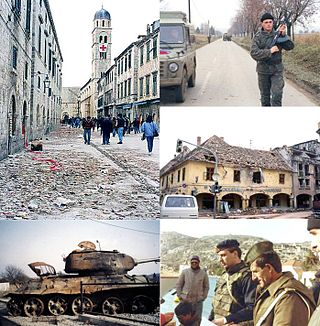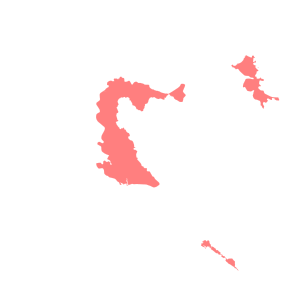The Plitvice Lakes incident was an armed clash at the beginning of the Croatian War of Independence. It was fought between Croatian police and armed forces from the Croatian Serb-established SAO Krajina at the Plitvice Lakes in Croatia, on 31 March 1991. The fighting followed the SAO Krajina's takeover of the Plitvice Lakes National Park and resulted in Croatia recapturing the area. The clash resulted in one killed on each side and contributed to the worsening ethnic tensions.

The Croatian War of Independence was fought from 1991 to 1995 between Croat forces loyal to the Government of Croatia—which had declared independence from the Socialist Federal Republic of Yugoslavia (SFRY)—and the Serb-controlled Yugoslav People's Army (JNA) and local Serb forces, with the JNA ending its combat operations in Croatia by 1992. In Croatia, the war is primarily referred to as the "Homeland War" and also as the "Greater-Serbian Aggression". In Serbian sources, "War in Croatia" and (rarely) "War in Krajina" are used.
The Vukovar massacre, also known as the Vukovar hospital massacre or the Ovčara massacre, was the killing of Croatian prisoners of war and civilians by Serb paramilitaries, to whom they had been turned over by the Yugoslav People's Army (JNA), at the Ovčara farm southeast of Vukovar on 20 November 1991, during the Croatian War of Independence. The massacre occurred shortly after Vukovar's capture by the JNA, Territorial Defence (TO), and paramilitaries from neighbouring Serbia. It was the largest massacre of the Croatian War of Independence.
The Lora prison camp was a prison camp in Split, Croatia. It was active from 1992 to 1997 with mainly Serbian residents of Split and prisoners of war being imprisoned throughout the Croatian War of Independence. The camp was the site of human rights abuses resulting in a controversial trial, acquittal, retrial and conviction of prison guards.
The Lovas killings involved the killing of 70 Croat civilian residents of the village of Lovas between 10 and 18 October 1991, during the Croatian War of Independence. The killings took place during and in the immediate aftermath of the occupation of the village by the Yugoslav People's Army (JNA) supported by Croatian Serb forces and Dušan Silni paramilitaries on 10 October, two days after Croatia declared independence from Yugoslavia. The occupation occurred during the Battle of Vukovar, as the JNA sought to consolidate its control over the area surrounding the city of Vukovar. The killings and abuse of the civilian population continued until 18 October, when troops guarding a group of civilians forced them to walk into a minefield at gunpoint and then opened fire upon them.
The Škabrnja massacre was the killing of 62 Croatian civilians and five prisoners of war by Serbian Autonomous Oblast Krajina Territorial Defence troops and the Yugoslav People's Army (JNA) in the villages of Škabrnja and Nadin east of Zadar on 18–19 November 1991, during the Croatian War of Independence. The massacre occurred shortly after an agreement to evacuate Zadar's JNA garrison following an increase in fighting between the Croatian National Guard and the JNA. Most of the killings were committed by SAO Krajina troops which followed the leading armoured JNA units fighting their way into Škabrnja on 18 November. During the initial attack, the attacking force employed a human shield of captured civilians forced to walk in front of armoured vehicles. Most of the civilian population fled the village and about 120–130 were captured by the JNA and detained in the village school and kindergarten. However, others who took shelter in basements were killed in or just outside their homes. A portion of those killed in the massacre were buried in a mass grave in Škabrnja, while dozens of bodies were turned over to Croatian authorities.
The Baćin massacre was the killing of 83 civilians just outside the village of Baćin, near Hrvatska Dubica, committed by Croatian Serb paramilitaries. The killings took place on 21 October 1991 during the Croatian War of Independence. Most of the civilians were Croats, but they also included two ethnic Serbs, taken from Hrvatska Dubica, Baćin and the nearby village of Cerovljani. The civilians were killed in the area of Krečane, at the very bank of the Una River, and their bodies were left unburied for two weeks. Most of them were subsequently bulldozed into a shallow mass grave, while a number of the bodies were thrown into the river.
The Saborsko massacre was the killing of 29 Croat residents of the village of Saborsko on 12 November 1991, following the seizure of the village in a Yugoslav People's Army and Croatian Serb offensive during the Croatian War of Independence. The fall of the town occurred as part of a JNA and Croatian Serb operation to capture a Croatian-held pocket centered on the town of Slunj, southeast of Karlovac. While the bulk of the civilian population fled with the surviving Croatian forces, those who remained in Saborsko were rounded up and either killed or expelled. The bodies of the victims were retrieved from two mass graves and several individual graves in 1995.

The Scorpions was a Serbian paramilitary unit active during the Yugoslav Wars. The unit was involved in war crimes during the wars in Croatia, Bosnia and Herzegovina, and Kosovo. After the wars, four members of the unit were found guilty of killing six prisoners during the Srebrenica massacre of July 1995 and five were found guilty of killing fourteen civilians, mostly women and children, during the Podujevo massacre in March 1999.

Serbia was involved in the Yugoslav Wars, which took place between 1991 and 1999—the war in Slovenia, the war in Croatia, the war in Bosnia, and Kosovo. From 1991 to 1997, Slobodan Milošević was the President of Serbia. Serbia was part of the Federal Republic of Yugoslavia (FRY). The International Criminal Tribunal for the Former Yugoslavia (ICTY) has established that Milošević was in control of Serb forces in Bosnia and Herzegovina and Croatia during the wars which were fought there from 1991 to 1995.

The Battle of Gospić was fought in the environs of Gospić, Croatia, from 29 August until 22 September 1991 during the Croatian War of Independence. The battle pitted the Yugoslav People's Army (JNA), stationed in five barracks in the town, and paramilitary elements of the Serbian Guard against the Croatian National Guard (ZNG), police forces based in Gospić and police reinforcements from elsewhere in Croatia. Fighting in the eastern districts of Gospić, controlled by JNA forces with supporting artillery, was largely static but the balance shifted in favor of the Croatian forces following the capture of several JNA depots and barracks on 14 September. The remaining barracks were captured by 20 September leading to the expulsion of the JNA and Serbian Guard forces from the town.

Kerestinec concentration camp was a prison that served as a concentration camp in Kerestinec, Independent State of Croatia during World War II. It was located in a castle overlooking the village.
The Varivode massacre was a mass killing that occurred on 28 September 1995 in the village of Varivode, Croatia during the Croatian War of Independence. According to United Nations officials, soldiers of the Croatian Army (HV) and Croatian police killed nine Serb villagers, all of whom were between the ages of 60 and 85. After the war, six former Croatian soldiers were tried for committing crimes in the village, but were all eventually released due to lack of evidence. In 2012, the Supreme Court of Croatia ruled that the Republic of Croatia was responsible for the killings, dubbing the massacre an "act of terrorism," and the following year the municipal court in Knin announced that the Government of Croatia must provide compensation to the children of a couple who were murdered.

The 1991 Yugoslav campaign in Croatia was a series of engagements between the Yugoslav People's Army (JNA), the Yugoslav Navy and the Yugoslav Air Force, and the Croatian National Guard (ZNG) then the Croatian Army (HV) during the Croatian War of Independence. The JNA was originally deployed in order to preserve Yugoslavia, and the initial plan of the campaign entailed the military occupation of Croatia and the removal of the Croatian leadership elected in 1990. The JNA intervention was the culmination of its involvement in the confiscation of weapons from Croatia's Territorial Defence, and in the Croatian Serb revolt that had begun in August 1990. From that time, the JNA had been frequently deployed to form a buffer zone between the insurgents and the ZNG or the Croatian police. In effect, these JNA buffer zones often secured the territorial gains of the insurgents and led to an increasingly hostile relationship between the JNA and Croatia. The JNA campaign plan was amended shortly before the campaign to include the relief of JNA barracks besieged by the ZNG. The besieging and subsequent capture of several JNA facilities allowed Croatia to arm its previously poorly equipped military and to equip new recruits.
The Battle of Logorište was fought east of Duga Resa and south of Karlovac, Croatia, from 4–6 November 1991 during the Croatian War of Independence, between the Croatian National Guard and the Yugoslav People's Army. The ZNG placed the JNA-held Logorište barracks under a blockade as part of the countrywide Battle of the Barracks, which aimed to pin down JNA units isolated in their bases and force them to surrender weapons and ammunition to the ZNG. However, the JNA garrison broke out from the besieged barracks with part of its stored equipment before the ZNG claimed the vacant base. The breakout was supported by JNA units and SAO Krajina units deployed to lift the blockade of the barracks and other JNA garrisons in Karlovac. A battle ensued as the ZNG attempted to contain advancing JNA units, ending with a ceasefire signed in The Hague.

Sakib Mahmuljin is a Bosniak politician and former military leader who served as the commander of the 3rd Corps of the Army of the Republic of Bosnia and Herzegovina (ARBiH) during the Bosnian War. After the war, he was convicted of committing war crimes against Bosnian Serb prisoners and sentenced to eight years' imprisonment.
Silos was a concentration camp operated by the Army of the Republic of Bosnia and Herzegovina (ARBiH) during the Bosnian War. Centered around a windowless grain silo, it was used to detain Bosnian Serb, and to a lesser extent Bosnian Croat, civilians between 1992 and 1996. The camp was located in the village of Tarčin, near the town of Hadžići, 10 kilometres (6.2 mi) west of Sarajevo. Inmates were subjected to beatings, given little food and kept in unsanitary conditions. Five-hundred Bosnian Serb and ninety Bosnian Croat civilians were detained at the camp; twenty-four prisoners lost their lives.
The Grubori massacre was the mass murder of six Serb civilians from the village of Grubori, near Knin, on 25 August 1995 by members of the Croatian Army (HV) in the aftermath of Operation Storm. The massacre was listed in the ICTY's indictment of Croatian wartime generals Ante Gotovina, Ivan Čermak and Mladen Markač.
The Pakračka Poljana camp was a makeshift prison camp where Croatian Serb civilians along with some Croats were held, tortured and executed by members of the Croatian Special Police commanded by Tomislav Merčep during the Croatian War of Independence. It was located Pakračka Poljana, near the town of Pakrac.








